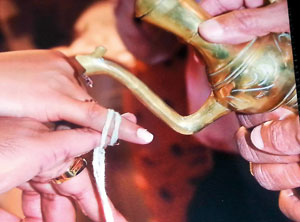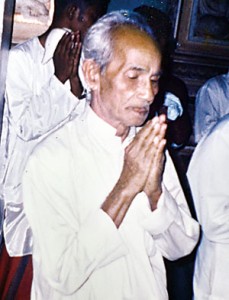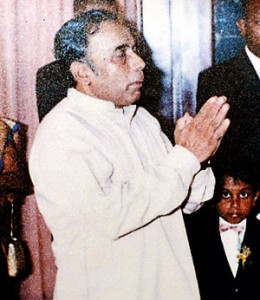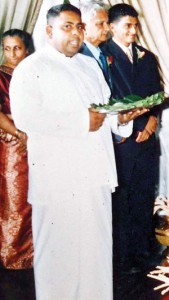Showering stanzas of blessings
 I am a descendant of the Amunugama Werapitiya family in Kandy. From the time of the kings, our family has been rendering their duties to the dalada perahera. We have served in the traditional dance troupe of the Diyawadana Nilame of Kandy Dalada Perahera for generations now. So tradition, arts and culture were very much a part of my life since my childhood.
I am a descendant of the Amunugama Werapitiya family in Kandy. From the time of the kings, our family has been rendering their duties to the dalada perahera. We have served in the traditional dance troupe of the Diyawadana Nilame of Kandy Dalada Perahera for generations now. So tradition, arts and culture were very much a part of my life since my childhood.My father, Somadasa Werapitiya (aged 67) and grandfather Ukkusara Werapitiya (he passed away 10 years ago at the age of 85) were both sought-after Ashtaka performers. My father, a traditional dance teacher and talented astrologer, took to this field in the ’80s. Even today, Somadasa Werapitiya is a popular name and that is the reason why he continues as an Ashtaka performer even after his retirement from the teaching profession.
I got into this in 2000, immediately after my schooling at Ananda College Colombo. Maybe I was pushed into this field without even realizing it due to the family influence, since I grew up in a family of traditional dancing teachers and astrologers. Even while continuing my higher studies at the university, I continued to conduct wedding ceremonies. I am a Political Science teacher now, but I did not give up on this family practice since I thought, as a member of the Amunugama Werapitya clan, it is my duty to safeguard and sustain our family heritage and identity. Depending on my availability, I take turns with my father, my brother and my uncle to conduct Poruwa ceremonies on a regular basis.
We get invitations almost every day- except for Tuesdays, which is generally considered an inauspicious day. In May and June this time, we had around 250 morning and evening weddings within Colombo to cover.

How I learnt the tradition was purely by accompanying my father and grandfather and by watching them conduct wedding ceremonies. Even while I was schooling, I used to go with my father whenever I had some free time to help him out with the Poruwa ceremonies. That was how I received my basic training. Whenever I went, I used to observe how these rituals are performed or the manner in which Ashtaka stanzas are recited. By listening to the Ashtaka verses and stanzas over a period of several years, I was able to memorize most of them, though later, as I grew up, I was given access to the traditional family palm leaf manuscripts (pus kola poth) and books containing Ashtaka verses referred to by my father and the grandfather.
“It is said that poruwa traditions started with the marriage ceremony of Prince Siddhartha (Lord Buddha before he attained Enlightenment) and Princess Yashodara. Since then, it became the Sinhala Buddhist tradition to conduct a poruwa ceremony when couples are given in marriage. Conducting poruwa tradition is symbolic of the blessings invoked on the new couple tying the nuptial knot. In days gone by, it was also believed that the poruwa ceremony is done only for couples of good conduct. So the poruwa ceremony was symbolic of the respect shown by society for such couples.
The rituals begin when the couple gets on the poruwa at an auspicious time given by the astrologer and several such rituals are performed until the bride and the groom get down from the poruwa. In between these rituals, Ashtaka verses are sung in Pali and Sanskrit. In the past, these rituals would go on for about one and half hours but the current practice is to restrict the ceremony to about 30 minutes. However, it is not by omitting any ritual that this poruwa ceremony has been cut short but by limiting the number ofAshtaka verses recited in between the rituals.
It is important to recite the Ashtaka stanzas in the correct manner. This is one of the key things that my father and grandfather used to advise me on while we were being trained. They repeatedly told me to pronounce the stanzas in the right manner and not to omit or change any words so that the new couple entering wedlock will be truly blessed. That requires an understanding of Pali and Sanskrit.

A family heritage: From grandfather (top) to father (above) to Manjula (below)
The poruwa ceremony has several rituals. When the couple get on to the poruwa, they are presented with a sheaf of betel by the Ashtaka performer and the couple hands it back to him to be placed at an elevated position. This signifies the offering to the deities(Ishta Devata).This would be followed by various other rituals such as exchange of seven sheaves of betel by the couple – an act performed to seek blessings of the relatives of seven generations, pouring pirith water using a pan kendiya on the small fingers of the couples’ right hand tied together with a thread -a ritual symbolic of the ancient Sinhalese tradition of pouring water whenever a handover takes place. This was a practice by the ancient Sinhala kings whenever they transferred their lands to the temples. Likewise, this ritual is performed during a marriage ceremony too.
Then there are several other customs such as tying a white cloth around the bride’s waist to express the groom’s commitment to provide the bride everything she needs for the rest of her life, presenting betel for the couple’s parents and elderly relatives, presenting the kahchiya- a white cloth of 16 metres to the bride’s mother as a mark of gratitude for bringing up the bride, singing of Jayamangala Gatha, exchange of rings and the tying of the necklace, the couple being fed with a piece of kiribath and a glass of milk by the bride’s and the groom’s mother to bless their new journey. In between all these rituals, Ashtaka will be recited.
“It’s impressive how this tradition of the poruwa ceremony has remained constantover the years. To see that people still consider the poruwa ceremony as something important even in these modern times is an encouragement for traditional Ashtaka performers like us to sustain this practice and pass it down to the future generations.”



